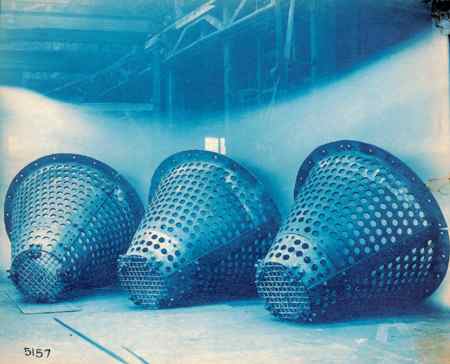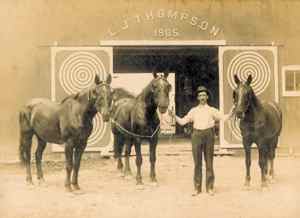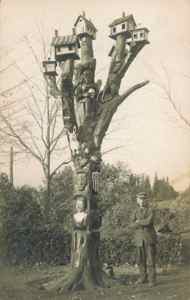
Editor's note: The Columbus Museum of Art provided source material to Resource Library for the following article or essay. If you have questions or comments regarding the source material, please contact the Columbus Museum of Art directly through either this phone number or web address:
Family Album: The James Rutkowski Collection of American Photographs

(above: Photographer unknown, Fabricated Steel Cones, circa 1905. Cyanotype. Collection of James Rutkowski)
Presented for the
first time in a comprehensive exhibition, Family Album: The James Rutkowski
Collection of  American
Photographs comprises a fresh critique of photography
as a collectible art form. The approximately 100 vernacular photographs
that comprise Family Album will be on view in the Columbus Museum
of Art 's Ross Photography Center September 11, 2004 - January 2, 2005.
(right: Photographer unknown, Man's Right Hand Holding Pen,
circa 1880. Silver print. Collection of James Rutkowski)
American
Photographs comprises a fresh critique of photography
as a collectible art form. The approximately 100 vernacular photographs
that comprise Family Album will be on view in the Columbus Museum
of Art 's Ross Photography Center September 11, 2004 - January 2, 2005.
(right: Photographer unknown, Man's Right Hand Holding Pen,
circa 1880. Silver print. Collection of James Rutkowski)
James Rutkwoski, a Detroit resident, has been amassing a collection of vernacular photographs for twenty years. These pictures represent pictures culled from the American popular cultural landscape rather than the established history of photography canon. Trained as a sculptor at Cranbrook Academy, Rutkowski became interested in photography because of its cross over into popular culture.
Rutkowski's collection spans the history of photography, from 19th century daguerreotypes to 20th century popular imaging, but has an independent and idiosyncratic voice. It has been shaped by areas that have traditionally fallen outside high art; for example, industrial and commercial pictures, and snap shots. The myriad images reflect the nexus of photography and American culture, a genre of photography increasingly visible in both museums and in the marketplace. This exhibition explores Rutkowski's particular approach in which the collecting activity is a kind of archeology-a process of sorting and culling.
Rutkowski began collecting photographs in 1972. He claims
it is an artistic and socially focused collection, not one that is monetarily
driven: "Dollars don't drive me, a relevant piece is more important
than the money." His  photographic
tastes are for images that reveal American situations that tell something
of the nation. His compass point is to build a significant collection based
on art and social history.
photographic
tastes are for images that reveal American situations that tell something
of the nation. His compass point is to build a significant collection based
on art and social history.
The Rutkowski Collection is best understood as a highly eclectic series of snap shots; glimpses of America recorded in all manners of photographic processes, and printed in a variety of formats. For Rutkowski, the meta-narrative of the collection encapsulates a single, universal message compiled from an ocean of particulars. He states, "We know who we are through snap shots, both as individuals and as a nation. There are commonalities in being American and in just being human." (right: L.J. Thompson, Target Doors on Horse Barn, circa 1905. Silver print. Collection of James Rutkowski)
As his collection grew, Rutkowski began putting together image "notebooks" or albums that allowed him to study his photographs in the context of the various theme groupings he was constructing. In creating his notebooks, Rutkowski revealed that his primary interest in his photographs was in the content. His collection became one of photographic images more than one of photography alone. Focusing his collection on the paired ideas of the American experience and the American identify, Rutkowski has gathered a remarkable assemblage of photographs that affirm what he understands as the timeless values of the American landscape and the successive waves of people who have inhabited that landscape.
Sharing his collection offers the audience a rare opportunity to sift and sort its way through a family photo album. Discovering something of oneself in the collection and constructing one's own album of memory, empathy and identity from the images allows the audience become collectors themselves.
Looking at photographs has had a social, intellectual and creative impact on Rutkowski. Photographs give him a deep, quiet pleasure, and allow him to discover new concepts and ideas in his own photos. Collecting photographs from this perspective, Rutkowski becomes a broker in a commerce where photo images, history and belief comprise a set of commonly held cultural goods.
A catalog with essays by guest curator Michael Hall and Shirley Wajda accompanies the exhibition. Michael Hall is a scholar, sculptor, and collector with expertise in American Scene painting and outsider art. Shirley Wajda, director of American Studies and affiliate in Women's Studies at Kent State University, has written extensively on material popular culture.

(above: Photographer unknown, Artist named Grant with Carved Tree, circa 1915. Silver print. Collection of James Rutkowski)
Read more articles and essays concerning this institutional source by visiting the sub-index page for the Columbus Museum of Art in Resource Library.
Visit the Table of Contents for Resource Library for thousands of articles and essays on American art, calendars, and much more.
Copyright 2003, 2004 Traditional Fine Arts Organization, Inc., an Arizona nonprofit corporation. All rights reserved.